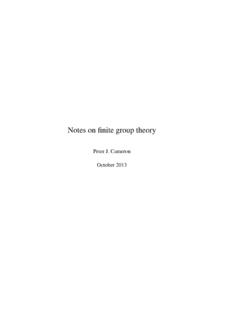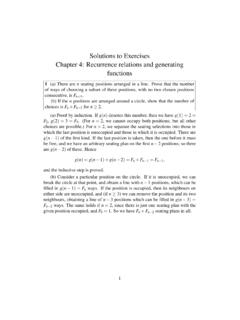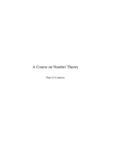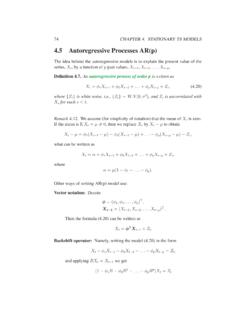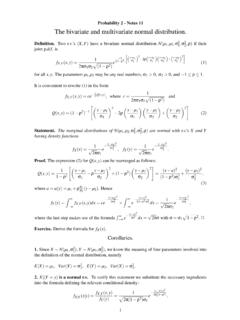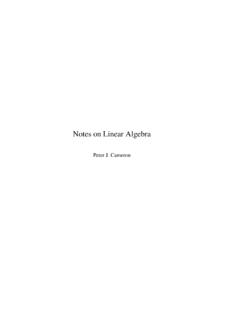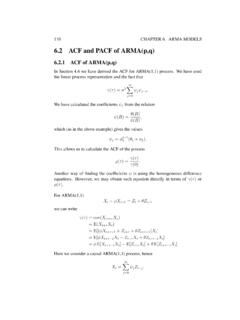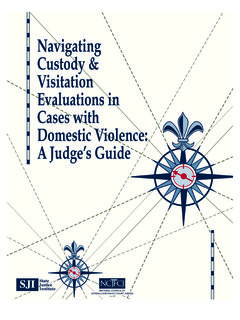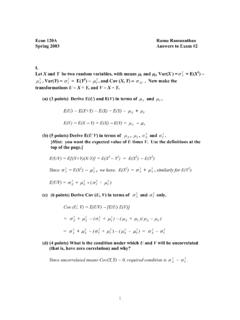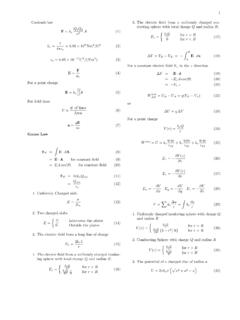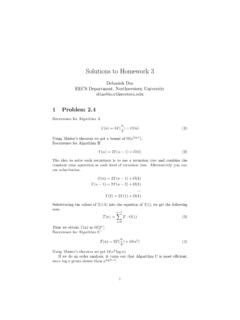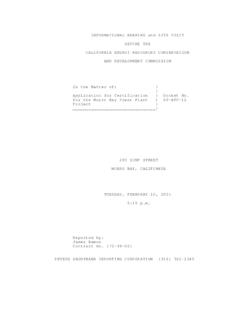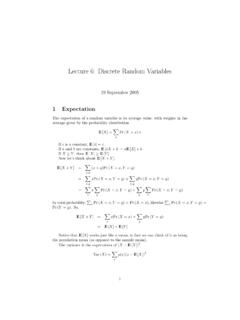Transcription of Probability 2 - Notes 5 Conditional expectations E X Y as ...
1 Probability 2 - Notes 5 Conditional expectationsE(X|Y)as random variablesConditional expectations were discussed in lectures (see also the second part of Notes 3). Thegoal of these Notes is to provide a summary of what has been done so far. We start by remindingthe main definitions and by listing several results which were proved in lectures (and Notes 3).LetXandYbe two discrete s with a joint ,Y(x,y) =P(X=x,Y=y). Rememberthat the distributions (or the s)fX(x) =P(X=x)ofXandfY(y) =P(Y=y)ofYarecalled the marginal distributions of the pare(X,Y)and thatfX(x) = yfX,Y(x,y)andfY(y) = xfX,Y(x,y).IffY(y)6=0, the Conditional ofX|Y=yis given byfX|Y(x|y)def=fX,Y(x,y)fY(y)and the condi-tional expectation byE(X|Y=y)def= xx fX|Y(x|y)and, more generally,E(g(X)|Y=y)def= xg(x)fX|Y(x|y),is defined for any real valued functiong(X). In particular,E(X2|Y=y)is obtained wheng(X) =X2andVar(X|Y=y) =E(X2|Y=y) [E(X|Y=y)] always suppose that x|g(x)|fX|Y(x|y) . (y) =E(X|Y=y). ThenE(X|Y)def= (Y).
2 In words,E(X|Y)is a randomvariable which is a function ofYtaking valueE(X|Y=y)whenY= (g(X)|Y)is defined similarly. In particularE(X2|Y)is obtained wheng(X) =X2andVar(X|Y) =E(X2|Y) [E(X|Y)] thatE(X|Y)is a random variable whereasE(X|Y=y)is a number (yis fixed).Theorem 1.(i)E[E(X|Y)] =E(X).(ii)Var(X) =Var[E(X|Y)]+E[Var(X|Y)]. lecture or Notes of random number of random variables (random sums).LetX1,X2,X3,..be a sequence of independent identically distributed random variables ( variables), each with the same distribution, each having common meana=E(X)andvariance 2=Var(X). HereXis a having the same distribution asXj. The sumS= Nj=1 Xjwhere the number in the sum,Nis also a random variable and is independent of theXj s. Thefollowing statement now follows from Theorem 2.(i)E[S] =E(X) E(N) =aE(N).(ii)Var(S) =Var(X) E(N)+[E(X)]2 Var(N) = 2E(N)+a2 Var(N).Proof.(i) SinceE[S|N=n] =E[ nj=1Xj] = nj=1E[Xj] =an, we obtain thatE[S|N]] =aN(bythe definition! ofE[S|N]]). But then, from (i) of Theorem 1, we obtain thatE[S] =E[E[S|N]] =E[aN] =aE[N].
3 2(ii) SimilarlyVar(S|N=n) =Var[ nj=1Xj] =n 2and henceVar(S|N) = 2N. By Theorem 1,(ii) we have thatVar(S) =E[Var(S|N)]+Var(E[S|N]) =E[N 2]+Var(aN) = 2E[N]+a2 Var(N).2 Example: findingE(Yn)andVar(Yn)for a branching that a BPYn,n=0,1,2,..,is defined byY0=1andYn+1=X(n)1+X(n)2+..+X(n)Yn,wher e sX(n)jare independent of each other and have the same distribution as a given integer-valued 2 can be used in order to prove the following statements:Suppose thatE(X) = ,Var(X) = 2. Then:(i)E(Yn) = n(ii)If 6=1, thenVar(Yn) = 2 n 1(1 n)(1 ).If =1thenVar(Yn) =n given in lectures (and a different proof can be found in Notes 4).Some additional properties of Conditional independent s thenE(X|Y) =E(X). we know,XandYare independent if and only iffX,Y(x,y) =fX(x)fY(y)or, equiva-lently,fX|Y(x|y) =fX(x). But thenE(X|Y=y) = xx fX|Y(x|y) = xx fX(x) =E(X). [E(g(X)|Y)] =E(g(X)) (X). Statement (i) of Theorem 1 applies to any two s. Hence, applying ittoZandYwe obtainE[E(Z|Y)] =E(Z)which is the same asE[E(g(X)|Y)] =E(g(X)).
4 2 This property may seem to be more general statement than (i) in Theorem 1. The proof aboveshows that in fact these are equivalent (XY|Y) =Y E(X|Y). (XY|Y=y) =E(yX|Y=y) =yE(X|Y=y)(becauseyis a constant). Hence,E(XY|Y) =Y E(X|Y)by the definition of the Conditional (XY) =E[Y E(X|Y)]. (XY) =E[E(XY|Y)] =E[Y E(X|Y)]. the same method to prove thatE(X h(Y)|Y) =h(Y)E(X|Y)for any real valuedfunctionh(y).


